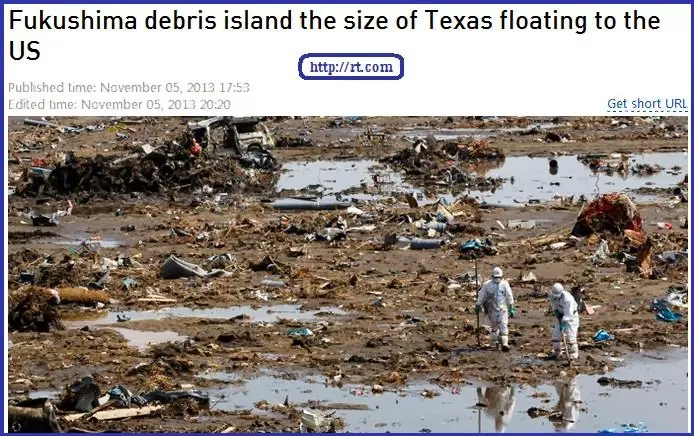Nearly 80 US Navy sailors who supported Japan after the Fukushima disaster demanded £612 million (US$1bn) from Tokyo Electric Power Plant (Tepco), operators of Fukushima. According to plaintiffs, over the last three years they have suffered from different diseases as a result of radiation exposure.
An earthquake that was followed by tsunami and nuclear disaster took place March 11,2011. The USS Ronald Reagan super-carrier was sent to the northeast coast of Japan to assist the country.
The vessel crew that includes sailors and support personnel claims that during the operation, called Operation Tomodachi, they were exposed to radioactive plumes. According to them, since the accident they have suffered from different health issues, ranging from cancer to fertility problems.
Their claims were submitted to San Diego District Court in California. Paul C Garner, a lawyer representing the Nevy sailors, says that "they are suing Tepco for negligence in permitting escape of radiation from Fukushima nuclear power plant, strict liability, fraudulent concealment of true facts and a $1 billion medical fund plus compensation."
This is an amended claim, as an earlier version was dismissed by the judge in San Diego last year.
The US government assured that the levels of radiation were too low and the sailors couldn't get their health damaged. The government also published a list of exposure details.
The US Navy spokesman told The Telegraph that after the operation all crew was monitored and the levels of radiation exposure were very low.
Vessels' personnel deny Government's proofs and continue to stand their ground.
Lt Steven Simmons, a 36-year-old administration officer, told that he had fallen ill within months of returning to the US from his deployment on the USS Reagan. He said that doctors didn't do internal and external monitoring of people. He also said that though he heard via intercom that "contaminants" got into water, he had already had his breakfast and had drunk several glasses of water. Mr. Simmons used to be a very healthy man. He used to doing the P90-X work out and claimed the "Stairway to Heaven" in Hawaii. After his return, his health began to decline. Today he is wheelchair bound father of three children. Doctors say that it can't be a radiation poisoning. Otherwise, Lt Simmons would have been affected earlier.
Tepco that is now facing a large number of lawsuits from Fukushima residents doesn't comment on the issue. The company's representative thanks the US for all its help and assures that the company would appropriate all measures, assigned by the Court in US.
Today, three years after the Fukushima disaster, concerns in the region are growing. Local city governments are adopting resolutions that stipulate more intensive testing of coastal seafood. Some scientists think that seaborne radiation from Fukushima will wash up on the US West Coast. Nevertheless, the most of scientists assure that radiation will decay or lessen to the concentrations that don't have any effect on people's health.
Voice of Russia, Telegraph
http://voiceofrussia.com/2014_02_09/US-Navy-sailors-sue-Fukushima-operators-for-600m-3939/
9/2/14
--
-
Related:
An earthquake that was followed by tsunami and nuclear disaster took place March 11,2011. The USS Ronald Reagan super-carrier was sent to the northeast coast of Japan to assist the country.
The vessel crew that includes sailors and support personnel claims that during the operation, called Operation Tomodachi, they were exposed to radioactive plumes. According to them, since the accident they have suffered from different health issues, ranging from cancer to fertility problems.
Their claims were submitted to San Diego District Court in California. Paul C Garner, a lawyer representing the Nevy sailors, says that "they are suing Tepco for negligence in permitting escape of radiation from Fukushima nuclear power plant, strict liability, fraudulent concealment of true facts and a $1 billion medical fund plus compensation."
This is an amended claim, as an earlier version was dismissed by the judge in San Diego last year.
The US government assured that the levels of radiation were too low and the sailors couldn't get their health damaged. The government also published a list of exposure details.
The US Navy spokesman told The Telegraph that after the operation all crew was monitored and the levels of radiation exposure were very low.
Vessels' personnel deny Government's proofs and continue to stand their ground.
Lt Steven Simmons, a 36-year-old administration officer, told that he had fallen ill within months of returning to the US from his deployment on the USS Reagan. He said that doctors didn't do internal and external monitoring of people. He also said that though he heard via intercom that "contaminants" got into water, he had already had his breakfast and had drunk several glasses of water. Mr. Simmons used to be a very healthy man. He used to doing the P90-X work out and claimed the "Stairway to Heaven" in Hawaii. After his return, his health began to decline. Today he is wheelchair bound father of three children. Doctors say that it can't be a radiation poisoning. Otherwise, Lt Simmons would have been affected earlier.
Tepco that is now facing a large number of lawsuits from Fukushima residents doesn't comment on the issue. The company's representative thanks the US for all its help and assures that the company would appropriate all measures, assigned by the Court in US.
Today, three years after the Fukushima disaster, concerns in the region are growing. Local city governments are adopting resolutions that stipulate more intensive testing of coastal seafood. Some scientists think that seaborne radiation from Fukushima will wash up on the US West Coast. Nevertheless, the most of scientists assure that radiation will decay or lessen to the concentrations that don't have any effect on people's health.
Voice of Russia, Telegraph
http://voiceofrussia.com/2014_02_09/US-Navy-sailors-sue-Fukushima-operators-for-600m-3939/
9/2/14
--
-
Related:

















 GR
GR FR
FR DE
DE ES
ES IT
IT RU
RU EU
EU